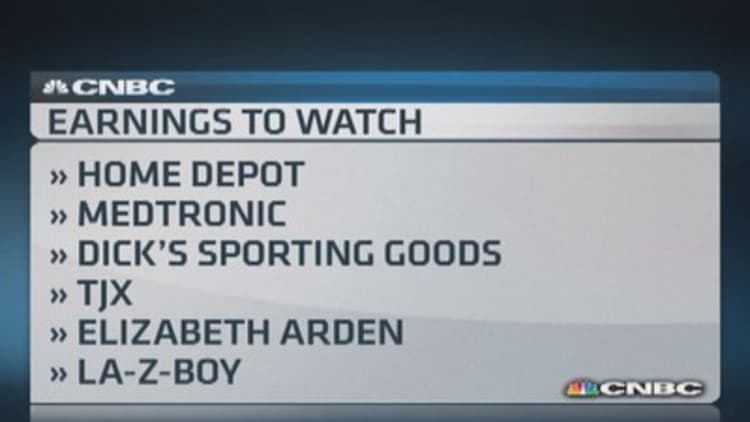
Barring a fresh geopolitical jolt, the S&P 500 is back on track to take aim at the psychological 2,000 level.
Stocks were buoyed Monday by the lack of new negative developments in Ukraine and Iraq. powered ahead on a triple-digit gain, and the S&P 500 vaulted ahead by 16 points, though it still remains below its July high of 1,991. The Nasdaq cracked a fresh 14-year high, reversing the entire 3.7 percent decline it made this summer.
"In the quiet, illiquid days of the summer, I could see the S&P getting close to but not exceeding the 2,000 point [level] if the geopolitical situation stays contained," said David Bianco, chief U.S. equity strategist at Deutsche Bank.
Stocks are also trading higher as bond yields come off of last week's lowest levels. The 10-year at 2.38 percent is still trading beneath a range it has been in for 14 months.
Some strategists expect the market to continue to see volatility and more selling pressure into the fall, even if stocks rise during the last weeks of summer. The Fed's Jackson Hole, Wyoming, symposium at the end of the week is also expected to send a dovish message to stocks, as the central bank's chair, Janet Yellen, reiterates her view that the labor market is still not healed, and interest rates should not rise for a while longer.
Read MoreBond market bullishness ramps up
But midterm elections could be a rocky time for stocks as investors focus on tax and other policy issues. September is also traditionally the worst month for stock market performance, and Morgan Stanley strategists warn it is the time with the most negative earnings revisions historically.
"We would expect more volatility over the course of September. You're in a seasonally weak period," said Scott Wren, senior equity strategist at Wells Fargo Advisors. "You could easily touch 2,000. That's one day of trading from here. The chances are in the near term, you are going to reach 2,000. I don't know if you'll stay there."
Read MoreStocks in risk off rally
Low bond yields are a source of worry for stocks, but Bianco said they could also be a source of encouragement.
"The remarkable thing is the persistent decline in long-term Treasury yields. ... We're all kind of thinking any significant increase in interest rates is still a while away and increasingly believing long-term interest rates will stay well below historical norms, through the cycle," said Bianco.
He said the norm of 4 percent may not even be seen before the next recession, which he sees as still several years away.
U.S. Treasury yields have followed European yields lower, as weak economic reports and geopolitical jitters sent German shorter duration bonds to negative yields and the 10-year bund yield fell below 1 percent for the first time ever last week. Weaker U.S. data, particularly July's flat retail sales, also triggered concerns for lower growth.
Earnings, however, have been a bright spot for stocks and could continue to be a catalyst, analysts said. "You'll probably get 10 percent earnings growth at the back half of the year," said Bianco. Second-quarter earnings grew at about 8 percent.
"I think the key issue to the right P/E is what you believe long-term interest rates are, and every time you turn around, the bond market is saying it's lower than you think," Bianco said. "It may be true that growth is slower than the long term, but still, on net, it argues for higher net P/Es than history."
Wren said based on current valuations, he does not see the stock market as overvalued, and a strong second-quarter earnings season has been a positive.
"Valuations are in no way, shape or form stretched," he said. Wren said the 16.7 price-to-earnings ratio on 2014 earnings is at the 30-year median.
Bill Stone, chief investment strategist at PNC Wealth Management, is more cautious about what lower yields mean for stocks.
"I'm of mixed feelings on that. I worry some of this is due to a weakening of the global economy," he said. "Certainly with Europe, you point the second-quarter GDP numbers and they were not pretty. It's treading water at best."
Stone said if the bond yields are low because they are forecasting slower growth, then it's a negative sign for stocks. "What separates the more bullish from the bearish is how they interpret that. Do they say the bond market is always right? Is it telling you the market is going to turn down, or does it tell you there's alot of other things going on," he said.
Whether the S&P gets to 2,000 soon is yet to be seen. "We'll get there eventually. I don't know about this week, but it certainly has the opportunity to be a more interesting week than one might expect from a week in August, with most people on vacation or wishing they were on vacation," he said.
Stone said until he sees a change in trend, the market has an upward bias. "Certainly, the U.S. earnings continued to be good. The second quarter showed up strong even though the market wasn't good during that period, and you've continued to see a bounce back in the U.S. economy, and it's always a question of how strong it really is. Those two things in my mind make it more likely to go up than down," he said.
Read More
—By CNBC's Patti Domm


